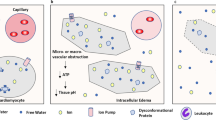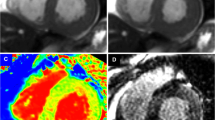Abstract
There is great interest to use magnetic resonance imaging (MRI) for non-invasive assessment of myocardial disease in ischemic and non-ischemic cardiomyopathies. Recently, there has been a renewed interest to use a magnetic resonance imaging (MRI) technique utilizing spin locking radiofrequency (RF) pulses, called T1ρ MRI. The spin locking RF pulse creates sensitivity to some mechanisms of nuclear relaxation such as 1H exchange between water and amide, amine and hydroxyl functional groups in molecules; consequently, there is the potential to non-invasively, and without exogenous contrast agents, obtain important molecular information from diseased myocardial tissue. The purpose of this article is to review and critically examine the recent published literature in the field related to T1ρ MRI of myocardial disease.








Similar content being viewed by others
References
Papers of particular interest, published recently, have been highlighted as: • Of importance •• Of major importance
Borthakur A, Mellon E, Niyogi S, Witschey W, Kneeland J, Reddy R. Sodium and T1rho MRI for molecular and diagnostic imaging of articular cartilage. NMR Biomed. 2006;19(7):781–821.
Witschey W, Borthakur A, Fenty M, Kneeland B, Lonner J, McArdle E, et al. T1rho MRI quantification of arthroscopically confirmed cartilage degeneration. Magn Reson Med. 2010;63(5):1376–82.
Grohn O, Kettunen M, Makela H, Penttonen M, Pitkanen A, Lukkarinen J, et al. Early detection of irreversible cerebral ischemia in the rat using dispersion of the magnetic resonance imaging relaxation time, T1rho. J Cereb Blood Flow Metab. 2000;20(10):1457–66.
Duvvuri U, Poptani H, Feldman M, Nadal-Desbarats L, Gee M, Lee W, et al. Quantitative T1rho magnetic resonance imaging of RIF-1 tumors in vivo: detection of early response to cyclophosphamide therapy. Cancer Res. 2001;61(21):7747–53.
Wang Y, Yuan J, Chu E, Go M, Huang H, Ahuja A, et al. T1rho MR imaging is sensitive to evaluate liver fibrosis: an experimental study in a rat biliary duct ligation model. Radiology. 2011;259(3):712–9.
Redfield A. Nuclear spin thermodynamics in the rotating frame. Science. 1969;164(3883):1015–23.
Palmer A, Massi F. Characterization of the dynamics of biomacromolecules using rotating-frame spin relaxation NMR spectroscopy. Chem Rev. 2006;106(5):1700–19.
Witschey W, Pilla J, Ferrari G, Koomalsingh K, Haris M, Hinmon R, et al. Rotating frame spin lattice relaxation in a swine model of chronic, left ventricular myocardial infarction. Magn Reson Med. 2010;64(5):1453–60. This study reports T 1ρ nuclear relaxation dispersion in excised myocardium and tissue 6–8 weeks post-infarction.
van Zijl P, Yadav N. Chemical exchange saturation transfer (CEST): what is in a name and what isn’t? Magn Reson Med. 2011;65(4):927–48.
Jin T, Autio J, Obata T, Kim S. Spin-locking versus chemical exchange saturation transfer MRI for investigating chemical exchange process between water and labile metabolite protons. Magn Reson Med. 2011;65(5):1448–60.
Haris M, Nanga R, Singh A, Cai K, Kogan F, Hariharan H, et al. Exchange rates of creatine kinase metabolites: feasibility of imaging creatine by chemical exchange saturation transfer MRI. NMR Biomed. 2012;25(11):1305–9. This study demonstrates a chemical exchange saturation transfer (CEST) MRI method for imaging creatine non-invasively in the heart.
Walker-Samuel S, Ramasawmy R, Torrealdea F, Rega M, Rajkumar V, Johnson S, et al. In vivo imaging of glucose uptake and metabolism in tumors. Nat Med. 2013;19(8):1067–72.
Muthupillai R, Flamm S, Wilson J, Pettigrew R, Dixon W. Acute myocardial infarction: tissue characterization with T1rho-weighted MR imaging–initial experience. Radiology. 2004;232(2):606–10.
Witschey W, Zsido G, Koomalsingh K, Kondo N, Minakawa M, Shuto T, et al. In vivo chronic myocardial infarction characterization by spin locked cardiovascular magnetic resonance. J Cardiovasc Magn Reson. 2012;14:37. T 1ρ MRI signal enhancement was shown in vivo in a large animal model of chronic myocardial infarction and correlated with late gadolinium-enhanced MRI.
Musthafa H, Dragneva G, Lottonen L, Merentie M, Petrov L, Heikura T, et al. Longitudinal rotating frame relaxation time measurements in infarcted mouse myocardium in vivo. Magn Reson Med. 2013;69(5):1389–95. This was a comprehensive serial study of T 1ρ relaxation in mice post-MI.
Huber S, Muthupillai R, Lambert B, Pereyra M, Napoli A, Flamm S. Tissue characterization of myocardial infarction using T1rho: influence of contrast dose and time of imaging after contrast administration. J Magn Reson Imaging. 2006;24(5):1040–6.
Witschey W, Borthakur A, Elliott M, Fenty M, Sochor M, Wang C, et al. T1rho-prepared balanced gradient echo for rapid 3D T1rho MRI. J Magn Reson Imaging. 2008;28(3):744–54.
Dixon W, Oshinski J, Trudeau J, Arnold B, Pettigrew R. Myocardial suppression in vivo by spin locking with composite pulses. Magn Reson Med. 1996;36(1):90–4.
Witschey W, Borthakur A, Elliott M, Mellon E, Niyogi S, Wallman D, et al. Artifacts in T1 rho-weighted imaging: compensation for B(1) and B(0) field imperfections. J Magn Reson. 2007;186(1):75–85.
Liimatainen T, Sorce D, O’Connell R, Garwood M, Michaeli S. MRI contrast from relaxation along a fictitious field (RAFF). Magn Reson Med. 2010;64(4):983–94. PMID: 20740665.
Wheaton A, Borthakur A, Reddy R. Application of the keyhole technique to T1rho relaxation mapping. J Magn Reson Imaging. 2003;18(6):745–9.
Richardson OC, Scott MLI, Tanner SF, Waterton JC, Buckley DL. Overcoming the low relaxivity of gadofosveset at high field with spin locking. Magn Reson Med. 2012;68(4):1234–8.
Moonen, RPM, van der Tol P, Hectors SJCG, Nicolay K, Strijkers GJ. Enhanced contrast of superparamagnetic iron oxide contrast agents by spin-lock MR. Proc Inter Soc Magn Reson Med. 2013. Salt Lake City, UT, USA
Acknowledgements
The authors thank Dr. Ravinder Reddy for reviewing this work and providing valuable insight and expertise.
Conflict of Interest
Yuchi Han, Timo Liimatainen, Robert C Gorman, Walter RT Witschey declare that they have no conflict of interest.
Human and Animal Rights and Informed Consent
This article does not contain any studies with human or animal subjects performed by any of the authors.
Author information
Authors and Affiliations
Corresponding author
Additional information
Sources of Funding
The authors gratefully acknowledge support from the National Institutes of Health, National Heart Lung and Blood Institute grants K99-HL108157, R01-HL063954, Cardiovascular Medical Research and Education Fund, the Academy of Finland and the Sigrid Juselius Foundation.
This article is part of the Topical Collection on Molecular Imaging
Rights and permissions
About this article
Cite this article
Han, Y., Liimatainen, T., Gorman, R.C. et al. Assessing Myocardial Disease Using T1ρ MRI. Curr Cardiovasc Imaging Rep 7, 9248 (2014). https://doi.org/10.1007/s12410-013-9248-7
Published:
DOI: https://doi.org/10.1007/s12410-013-9248-7




